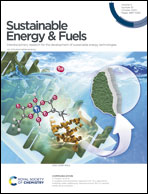Two-dimensional CuAg/Ti3C2 catalyst for electrochemical synthesis of ammonia under ambient conditions: a combined experimental and theoretical study†
Abstract
The Haber–Bosch process is one of the most widely utilized approaches for the synthesis of ammonia, and has many disadvantages, such as the high energy consumption and generation of large amounts of greenhouse gases. Therefore, the electrochemical nitrogen reduction reaction (NRR) has received significant attention, as it is more sustainable and environmentally friendly. In this study, we report a CuAg/Ti3C2 MXene catalyst for the electrocatalytic NRR. This MXene-based composite material exhibits remarkable performance for electrochemical synthesis of ammonia under ambient conditions. When measured in a 0.1 M KOH solution at an applied potential of −0.5 V vs. reversible hydrogen electrode (RHE), the catalyst achieved an ammonia production rate and faradaic efficiency of 4.12 μmol cm−2 h−1 and 9.77%, respectively. These values indicate excellent stability and selectivity compared with the previously reported 2D NRR electrocatalysts. Moreover, the results of density functional theory calculations illustrate that with preferable adsorption of N2, desorption of NH3, and suppression of the HER, CuAg/Ti3C2 is a promising catalyst for the NRR. The excellent electrical conductivity and fast electron transport in the CuAg/Ti3C2 catalyst are favorable for the evaluated electrocatalytic reaction. Both experimental results and DFT calculations reveal that CuAg plays a crucial role in the catalytic activity and electrical conductivity enhancement for Ti3C2 based materials.



 Please wait while we load your content...
Please wait while we load your content...